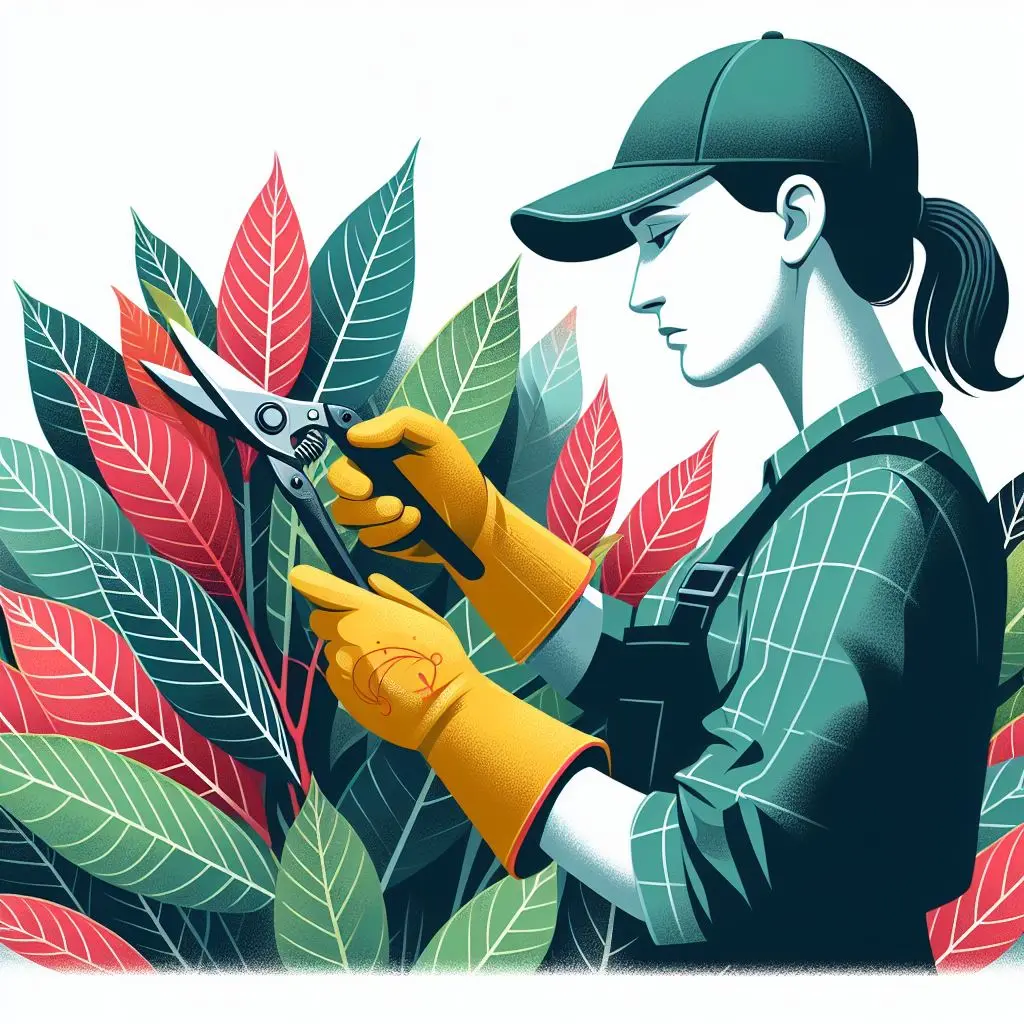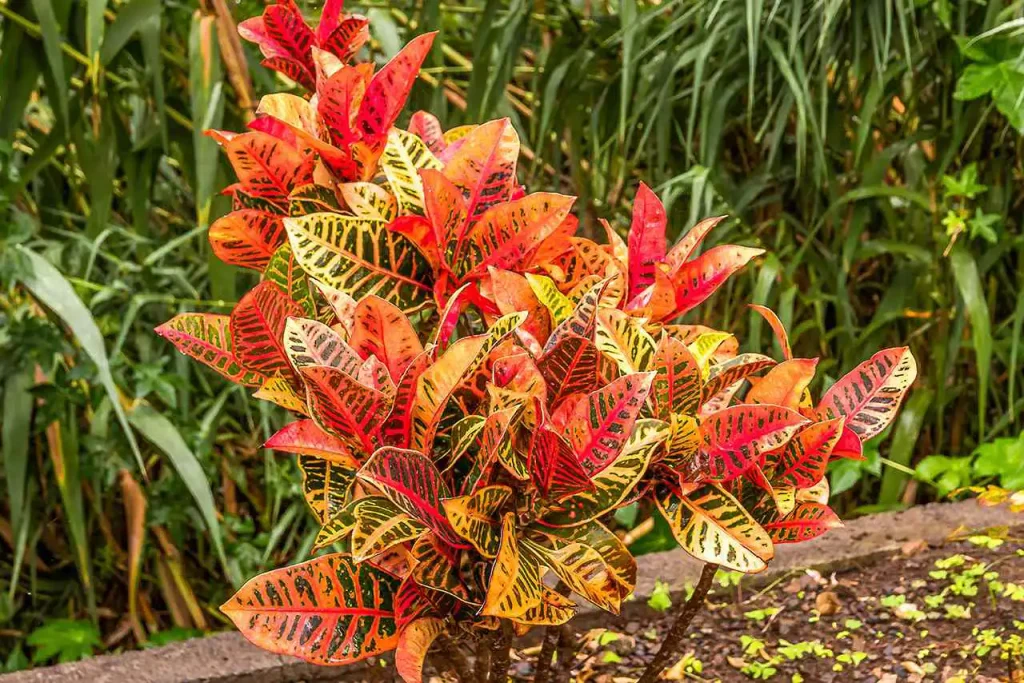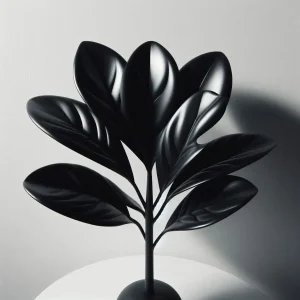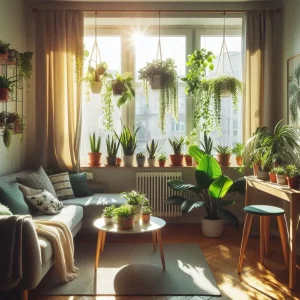If the Croton plant has thrived in suitable conditions, it can retain more of its leaves, keeping them close to the soil surface. To achieve this, it’s essential to maintain a constant warmth in the environment. Croton plants are highly sensitive to temperature changes, to the extent that specimens kept outdoors may experience leaf shedding after a cold night. If you want your Croton plant to have more vibrant and lively leaves, providing adequate light is crucial. Place the plant in a bright location that doesn’t receive direct sunlight all the time.
| Topic | Tips |
| Pot Selection | Choose a pot that is sufficiently large with good drainage to avoid frequent repotting. |
| Propagation Method | Propagate Croton plants through stem cuttings during the spring season. Use a rooting hormone solution or water for rooting. |
| Optimal Propagation Time | Spring is the preferred season for successful Croton plant propagation. |
| Common Pests and Diseases | Watch out for bacterial infections like gall, and fungal diseases such as anthracnose. Deal with pests like aphids and mites using suitable pesticides. |
| Changing Pots | Change the pot every three years or when roots are visible through drainage holes. Use a larger pot with adequate drainage. |
| Winter Care | Croton plants are sensitive to cold air. Bring them indoors in cold climates or use protective covers. |
| Flowering | Croton may flower outdoors but rarely indoors. Provide adequate light, moist soil, and a temperature range of 21-27°C. |
| Common Care Issues | Address issues like leaf discoloration, curling, or dropping by adjusting light, humidity, and nutrient levels. |
If you keep the Croton plant in an environment with insufficient humidity, it becomes susceptible to pest infestations, especially spider mites. To prevent pest attacks, mist the plant daily. If the Croton plant has adapted well to the climatic conditions and is positioned in a place with suitable light, it can thrive outdoors and withstand temperatures above 10 degrees Celsius, provided that the temperature remains stable and doesn’t drop below 10 degrees Celsius.
Light
Page Contents
ToggleThe Croton plant requires a bright location without direct exposure to sunlight. In some cases, the plant cannot tolerate direct sunlight. Additionally, it should be kept in a place where it is not always in direct sunlight, meaning it should have some shade during certain hours of the day. The vibrancy of this plant depends on receiving sufficient and appropriate light. If the Croton plant doesn’t receive the required light, its leaves will turn green.
For the Croton plant to exhibit vibrant colors, it needs 6 to 8 hours of direct sunlight. Placing it near east or west-facing windows, which receive direct sunlight, is the best location for this plant.”
Watering
In the summer, the soil for Croton plants should remain consistently moist. The Croton plant requires approximately 3 centimeters of water every week. During the winter, reduce watering and irrigate the plant once every two weeks. However, if the plant shows signs of needing more water, such as wilting stems and younger leaves, pay closer attention and adjust the watering accordingly. If the plant exhibits noticeable wilting during warm weather, check the surface moisture of the soil (approximately five centimeters deep) with your finger. If the soil is dry at this depth, increase watering. If the surface soil is already moist, the plant may have other issues, and you should not increase watering. During the growth season, it’s advisable to mist the Croton plant multiple times.
Soil
An ideal soil for Croton plants is well-draining, moist, and enriched with compost. The plant prefers soil with good aeration and acidity.
Temperature and Humidity
The optimal temperature for caring for Croton plants indoors is above 15 degrees Celsius. Additionally, avoid exposing the plant to cold drafts. Insufficient humidity, coupled with low light, can affect leaf color. The air humidity should be between 40% and 80%. If the air humidity is below the necessary level, the plant may experience leaf drop. To maintain humidity, you can use a humidifier or implement the tray of water method. If you prepare a larger tray and place multiple plants together, this method will be more effective in increasing and preserving humidity.
Fertilization
During the growth season, from early March to late September, use slow-release fertilizers three times; in early spring, mid-summer, and early fall. Alternatively, you can use liquid fertilizers once a month throughout the growth season. Since fertilizers come in various types, read the instructions on the packaging to apply nutrients based on the recommended dosage. Generally, you can reduce the recommended amount by half for a regular fertilization schedule. Assess the plant’s growth in the month following fertilization and adjust the nutrient levels accordingly. Avoid fertilizing during winter.
As Croton plants prefer slightly acidic soils, use acidic fertilizers containing ammonium nitrate, ammonium sulfate, or urea with sulfur coating. It’s recommended to use NPK compound fertilizers containing nitrogen, phosphorus, and potassium. The best ratios are 3-1-2 and 8-2-10.
Pruning

Croton plants respond well to pruning. If your plant has numerous tall and thin stems, prune it entirely at the beginning of the growth season. Remove damaged and unhealthy leaves and stems, or if you want to preserve a specific shape, cut the main stems just above the last node or leaf cluster. However, avoid removing more than one-third of a stem during each pruning session.
After pruning, the plant will regrow from the pruned section. If you are keeping the Croton plant indoors and have pruned it, gradually acclimate it to outdoor conditions over a week, and then transfer it to an outdoor environment.”
Propagation of Croton Plants
You can propagate Croton plants at any time of the year, provided that the temperature conditions are suitable. In tropical regions where the air temperature remains between 21 to 27 degrees Celsius consistently, if you are cultivating Croton plants outdoors, you can propagate them throughout the year. Moreover, if you can maintain the desired temperature in an indoor environment, you can also proceed with propagation.
Croton plants do not propagate well through seeds. In some plants, the new plant that grows from sowing their seeds can be different from the parent plant, and Croton plants are no exception. These plants propagate easily through stem cuttings. Using the method of stem cutting for propagation not only strengthens the growth of the parent plant but also promotes more consistent growth in the new plant. Placing the cut end of the stem in a solution containing rooting hormone increases the chances of successful propagation.”
In certain instances, Croton plants produce sports. In botany, sports are branches that branch off from the main plant but differ completely from the parent plant. You can use younger sports for propagating a new and different indoor plant. However, if you want to propagate the original plant, you should use stems that are consistent with the parent plant for cutting. You can also propagate the Croton plant through division. To execute this method, you will need clean gardening shears, well-draining potting soil (a mixture of sand, peat moss, and vermiculite), and a pot. Although rooting hormone can be added to these tools, it is not strictly necessary for successful propagation. Additionally, if you live in tropical regions and plan to plant the Croton outdoors, you don’t need a pot. After acquiring the necessary items, follow these steps:
- Select a stem of the plant that has a thickness equivalent to a pencil. Use sharp and clean gardening shears to cut a 10 to 15 centimeter section of the stem at a 45-degree angle. Make the cut exactly above the point where one of the leaves connects to the stem. Ensure the stem has a minimum of three leaves.
- If you have obtained rooting hormone, dip the cut end of the stem into the hormone solution.
- Plant the cutting in moist soil. A planting depth of 2 to 4 centimeters is sufficient.
- Place the planted cutting in a warm, sunlit location, avoiding exposure to cold drafts.
- Keep the soil moist. However, avoid increasing soil moisture to the extent that the soil becomes completely saturated.
- You can place the pot inside a transparent plastic bag to create a small greenhouse environment. This aids in better root development of the cuttings, similar to using rooting hormone. However, use the plastic bag only during the first week after planting.
- It takes four weeks for the roots to grow sufficiently. If you observe new growth on the planted cutting, root development has been successful. To check for root development, gently shake the cutting. If you feel resistance, the cutting has roots.
- Once you are certain about the root development of the cuttings and sufficient root growth, you can transplant the new plants into a larger pot or into the garden.”
Repotting Croton Plants
During the first three years of growth, young Croton plants need to be repotted once a year, and this should be done in spring or early summer. After this initial period, only repot when the roots have emerged from the drainage holes or are visible on the soil surface. Choose a new pot with an adequate number of drainage holes and only one size larger than the current pot. Fill between 2 to 5 centimeters of the new pot with suitable soil, preferably a mixture containing more peat moss, and keep it moist.
Remove the Croton plant from the old pot. To properly do this, gently move the plant from side to side and then lift the plant upward slowly. Place the plant in the center of the new pot and fill around the roots with soil. Water the plant, and if necessary, add more soil to the pot. Ensure that the amount of soil in the pot is less than 3 centimeters from the edge.
Wintering
Croton plants are sensitive to cold air. If you live in colder regions, it’s advisable to keep the plant indoors. Additionally, if you reside in an area where temperatures sharply drop at times, it’s better to choose an indoor space and pot to safeguard the Croton plant. Generally, if you keep the Croton plant outdoors, transfer it to an indoor space when the temperature drops below 10 degrees Celsius.
If you have planted the Croton in your garden, to protect the plant from sudden and severe temperature drops, cover the soil surface around the plant with mulch or ground cover. Use enough mulch to create coverage on the soil to less than 3 centimeters from the surface. This covering acts as insulation, preventing root frost. Furthermore, for protection against freezing, you can use protective covers. To avoid damage to leaves and stems from the weight of the cover, use supportive stakes. These protective covers not only shield the plant from frost but also protect it from strong winds. They can be used to help maintain the environmental temperature. However, ensure that the cover is securely fastened to the stakes; otherwise, strong winds can damage both the cover and the plant.”
Common Pests and Diseases
The Croton plant is susceptible to certain diseases and pest infestations. One of the most common bacterial infections is gall mite, causing thick and swollen protrusions called galls on the stems and leaf veins. If your plant is infected, there’s no cure, and it’s recommended to disinfect the pot and gardening tools after removing the affected plant to prevent the spread of the disease. Failure to prevent its spread to other plants may result in losing many of your plants.
Another disease affecting Croton is anthracnose, a fungal disease causing brown spots on the leaves. Prune and remove the infected leaves and stems, ensuring they don’t come into contact with other plants, as anthracnose spreads through spores. For severe infections, you may need to use fungicides containing copper as the main component.
Insects that commonly target Croton include mealybugs, scale insects, spider mites, and whiteflies. You can use insecticides to control each of these pests. Failure to address the issue promptly can halt the plant’s growth, cause leaf drop, and potentially lead to plant loss.
Read more:25 Top most beautiful indoor plants
Flowering of Croton Plants

If you keep Croton plants outdoors, they can produce flowers, but when kept indoors, flowering is rare. Croton flowers are small, star-shaped blooms on tall, slender stems with no significant fragrance. The flowering of Croton is not season-specific, occurring whenever ideal conditions are met, including sufficient light, moist soil, slightly acidic and nutrient-rich conditions, and temperatures between 21 to 27 degrees Celsius. Transferring the plant to an outdoor space during favorable conditions may encourage flowering.
What type of soil is best for croton plants? The ambius site answers like this:
Croton plants grow best in soil that allows for adequate drainage while maintaining sufficient moisture for growth. If the growing medium retains too much water, the plant may be susceptible to root rot.
Common Care Issues for Croton Plants
Croton plants are sensitive and require careful attention. Cold air, low humidity, improper soil, and nutrient deficiencies can impact their health and lead to various problems, including pests, diseases, and loss of vibrancy. Adequate care is necessary for a healthy, thriving plant.
Leaf Dulling
If Croton receives sufficient light, it displays vibrant colors. However, extreme heat can result in dulling and greying of the leaves. During hot weather, reduce or stop fertilization. Croton can endure high temperatures, but excessive heat can lead to greying leaves. Using ventilation systems like fans can help cool the plant and maintain leaf health. Adequate watering is crucial during hot days to prevent water stress.
Leaf Curling
When leaves become large, dark, and curled at the edges, it may indicate overgrowth. Reduce fertilization to correct this issue. Plants facing this problem have likely grown rapidly. Additional light may also be required for proper growth. If possible, move the plant to a brighter location.
Leaf Drop
A decrease in environmental temperature or exposure to cold air can lead to leaf drop in Croton. If the plant is kept outdoors and the air temperature is predicted to fall below 10 degrees Celsius, consider moving it to an indoor space. Additionally, inspect the lower parts of the leaves for tiny eggs or insects, as pests like spider mites or mealybugs can cause leaf drop. Clean the affected leaves with insecticidal soap to eliminate pests.
These measures can help address and prevent common issues in Croton plants, ensuring their health and vibrancy.
Frequently Asked Questions about Caring for Croton Plants at Home
What is the suitable pot for growing Croton plants?
A suitable pot for Croton plants should be large enough to accommodate the roots well, preventing the need for frequent repotting. Proper drainage in the pot is also crucial.
What is the best method for propagating Croton plants?
Croton plants propagate well through stem cuttings. Simply cut a suitable stem with a sterile sharp knife and place it in a container of water to develop roots. Regularly change the water, or you can use a rooting hormone solution.
When is the best time to propagate Croton plants?
It’s preferable to propagate Croton plants during the spring season for optimal results.
These are essential tips for maintaining and propagating Croton plants at home.







